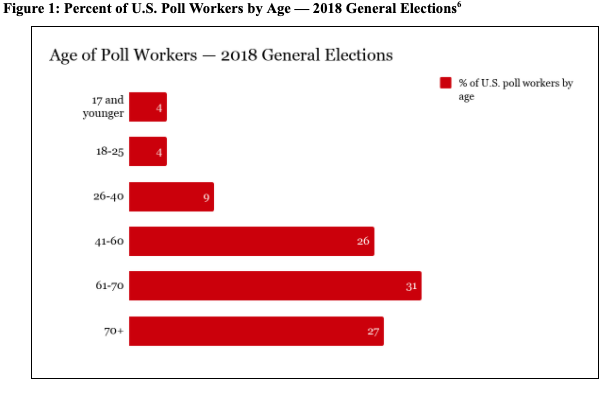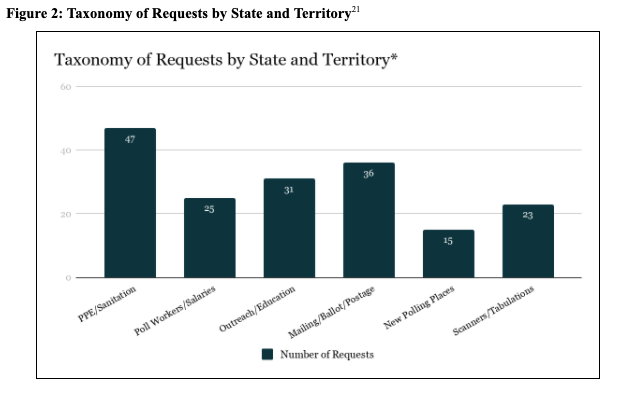There are just 96 days until the November elections. Whether states will have the tools to provide safe and secure options to vote depends in part on the amount of funding that states receive from Congress in the next COVID-19 relief package, and the conditions attached to that funding. These changes should be circumspect and limited to the 2020 election cycle for now.
Background
In April, Niskanen discussed the critical $400 million investment dedicated to election security for the states as part of the historic $2 trillion coronavirus aid package passed this spring. But election experts estimate that states will need significant additional funding to ensure that November elections are safe and secure.
Over half of voters (67 percent) believe that COVID-19 will significantly disrupt Americans’ ability to vote in November—that includes 50 percent of Republicans and 80 percent of Democrats. We’ve already seen evidence in the primary elections that these fears are hardly unfounded. We also know that poll workers are at heightened risk of infection. Of the 53 percent of poll worker respondents who reported their ages to the 2017 Election Administration and Voting Survey (EAVS), 24 percent were 71 and older; 32 percent were between the ages of 61 and 70.

We reviewed many of the challenges states face in coming elections in a recent piece. Among these challenges: a taxonomy of the kinds of support states need to avoid sudden poll closures, poll worker shortages, poll workers with inadequate training, malfunctioning machines, and long lines.

Even in states that received federal funding, primary elections posed various challenges. Following the primary elections in Wisconsin at the height of the pandemic in that state, the Milwaukee Health Department estimated that 52 voters and two poll workers were infected by COVID-19 while voting in person in Milwaukee County alone last month. Many more people likely contracted the illness while performing their civic duty, and it could prove fatal for an untold number of them. And many more voters, particularly voters of color, feel unsafe exercising their right to vote.
Bipartisan lawmakers are spearheading calls for reforms. In April, Rep. Rodney Davis (R-IL-13) supported the President of the National Association of Secretaries of State in calling for important reforms to the initial grants and appealing for more support. Last month, a group of right-of-center organizations, including the Niskanen Center, requested additional investments to ensure that Americans can safely vote.
Even without the pandemic, the number of absentee voters in the 2020 presidential election would have increased given this trend. But during the pandemic, we are seeing an exponential increase in the demand to vote from home—with some states seeing as many as ten times the number of absentee ballot requests for primaries than in previous years. For example, just this week, Texas Governor Greg Abbott opened voting for general elections a week earlier than planned to accommodate changes to polling places and reduce the burden on the voting system.
Incorporating similar changes in just five other states—Michigan, Pennsylvania, Georgia, Missouri, and Ohio is estimated to cost $414 million. Several states are near or below 50 percent of the total remaining funds for the general election, including GA, KY, MD, NM, NY, & SC.

For many states, the funding will help secure PPE and protect voting processes. According to NiskanenCenter analysis, most states’ funding has been spent on securing voting processes, staffing, security and training, communications, and sanitary supplies.

These are the kinds of changes that need financial support. We need to help states develop the infrastructure necessary to support changed voter behaviors to accommodate voting during a pandemic, protect voters and election workers, and educate the public about voting changes, new poll locations, and security processes. Mass disenfranchisement of voters on this scale may put the integrity of American democracy at risk. No American should have to choose between staying safe and exercising a Constitutional right.
Recommendations
Based on Niskanen research about the cost of elections, funding resources allocated and expended, and additional expected costs of providing PPE, these are our recommendations for Phase 4:
Allocate at least an additional $600 million to the states and waive 20 percent funding match for disbursement of election support funding from CARES Act, which will provide an additional $80 million available to states that already received funding.
Waive the 20 percent state funding match for disbursement of election support funding from CARES Act in exigent circumstances and provide additional election assistance funding. Per the CARES Act, states must match 20 percent of the total amount awarded and incur costs to meet that amount by March 27, 2022. If states meet the match requirements, they must deposit nearly $80 million ($79,519,998.00) to utilize the federal grants.
For several states, this requirement is problematic. Maine is struggling to claim the $3,299,827 offered by the federal government in the CARES Act, because it can’t appropriate the $659,965 owed for its matching portion, as the legislature is currently adjourned. About 15 state legislatures have already adjourned for the year, which means that unless they can call a special session to order before the December 31, 2020 expiration date, they will not reconvene until early 2021 and cannot appropriate matching funds. Plummeting state revenue is an increasing obstacle to securing matching funding, even if a state legislature is in session. Accessing and appropriating the matching 20 percent to receive federal funds is exacerbated by the states’ respective needs.
State and county leaders continue to express concern about mounting election costs. Officials in Ohio have suggested that even after receiving $12 million from the CARES Act, they need an additional $66-86 million to cover primary and November election- associated costs.
Provide additional funding for PPE and crackdown on COVID-19 procurement scams.
Provide additional funding for PPE and crackdown on COVID-19 procurement scams. On April 2, the National Association of Secretaries of State (NASS) underscored ongoing concerns about financial hardship due to the difficulty procuring quality PPE.
According to a recent report by ProPublica, the scarcity of masks and other PPE has created an unregulated and chaotic market that pits states against one another in bidding wars—which also inevitably drives up costs.
Federal and state contracts with untested companies have resulted in payments “as much as six times the manufacturer’s list price.” This exacerbates the growing state/county deficits and creates a significant opportunity for fraud.
Delay the 20-day reporting requirement for states and extend the obligation date and extend expenditure deadline from December 30, 2020, to June 30, 2021, to ensure states have time to finalize results of November elections and can accurately account for resources spent.
Delay the 20-day reporting requirement for states and extend the obligation date. For many states, these requirements are unnecessarily arduous, and the short designated timeframe is a recipe for incomplete analysis or noncompliance.
Here’s why: Elections don’t end on Election Day. Processes like signature verification, tabulating votes, certifying and auditing the election, etc. can take election officials days, weeks, and sometimes months to complete.
Equally troublesome is the requirement that states obligate or spend all CARES Act funding by December 31, 2020. Again, as highlighted by NASS, this deadline is complicated by the adjournment of legislatures and other appropriations restraints.
Extending the reporting deadline to June 1, 2021, and allowing states to reimburse any costs incurred in the administration of the elections through March 1, 2021, will help ensure comprehensive reporting on total expenditures.
Create a new program that funds university and college students to work to prepare for and administer elections.
One of the most urgent threats to a safe and secure election is poll workers’ availability to work leading up to and on election day. This was most recently evidenced by the chaotic primary elections in Georgia, Washington D.C., Pennsylvania, and South Carolina. In multiple counties across America, voters waited in line for up to seven hours, while attempting to maintain social distance. These arduous wait times were, in part, because of a shortage of polling staff, which are critical to ensuring a smooth voting process.
The older average age of poll workers is particularly problematic, given their higher risk for COVID-19.
For example, in the 2018 general election, six-in-ten poll workers were 60 or older, and a quarter were over 70 years old.
This is why–in addition to providing quality protective gear for poll workers of all ages–a grant program should be set up that incentivizes college-age individuals to participate in election administration– particularly, to work polls across America on election day.
The concern about a second wave of the virus in the fall, coupled with the difficulty in finding poll workers, is of particular concern amidst the pandemic. This is why it makes sense to encourage lower-risk individuals to alleviate some of the burden from older polling workers.
College-age students are significantly less likely to experience severe complications from COVID-19. Currently, the relative risk of dying from COVID-19 for individuals ages 15-24 is 0.55 (deaths per 100,000 population), whereas the risk jumps to 2.24 for individuals 45-54; 2.09 for individuals ages 55-64; and 2.13 for individuals between the ages of 65-74. In order to minimize health risks associated with voting in-person and working in election administration, it makes sense to utilize the populations that are least likely to develop severe complications: healthy, low-risk, college-age students. And for many in that age demographic, payment for the work is becoming increasingly necessary.
To ease the financial hardship, many Americans are currently experiencing, the CARES Act provides economic impact payments to most individuals making less than $75,000 per year. Parents with children 16 and under are also eligible for an additional $500 per child, leaving “children” still claimed as dependents on their parents’ tax return (aged 17 to 24) ineligible for stimulus funds.
For the 16.9 million students enrolled in colleges and universities across America, COVID-19 presents an unprecedented challenge. Many students are in debt and rely on work programs on campus or temporary summer jobs to supplement the cost of classes, car payments, and interest on student loans. High unemployment, the loss of campus jobs due to school closures, and ineligibility for stimulus funds have put many college-age students in significant financial hardship.
Legislation that offers temporary grants to college-age individuals to play a more active role in upcoming elections will help Americans participate safely in in-person voting (if they choose). It would also provide financial assistance to struggling students, and encourage civic engagement across the spectrum. We strongly urge lawmakers to consider this proposition when debating the next COVID-19 response legislation this summer.
Conclusion
We don’t see a one-size-fits-all solution for election security in every state. Still, we do see the need for responsive guidelines that take seriously the risks associated with elections during a pandemic.